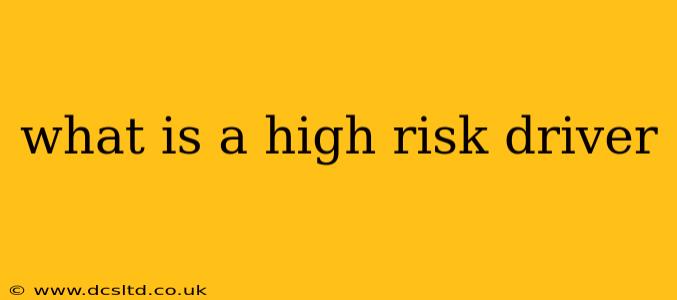A high-risk driver is someone who demonstrates a significantly higher probability of causing a car accident than the average driver. This isn't just about speeding tickets; it's a multifaceted assessment encompassing various behaviors and characteristics that increase the likelihood of collisions, injuries, and fatalities. Insurance companies, law enforcement, and even employers use different criteria to define and identify high-risk drivers, but several key factors consistently emerge.
What factors make someone a high-risk driver?
This section addresses several frequently asked questions related to high-risk drivers, drawing upon insights from insurance companies, traffic safety data, and legal frameworks.
What are some common characteristics of high-risk drivers?
High-risk drivers often exhibit a pattern of risky behaviors behind the wheel. These can include:
- Frequent speeding: Consistently exceeding speed limits significantly increases the risk of accidents.
- Reckless driving: This encompasses a range of actions like tailgating, weaving through traffic, running red lights, or making sudden, unpredictable maneuvers.
- Driving under the influence (DUI/DWI): Impaired driving due to alcohol or drugs is a leading cause of fatal accidents and a major marker of high-risk status.
- Multiple traffic violations: A history of numerous moving violations (speeding tickets, reckless driving citations, etc.) signals a disregard for traffic laws.
- At-fault accidents: Being at fault in multiple car accidents demonstrates a consistent inability to drive safely.
- Young age: Statistically, younger drivers (typically under 25) are more likely to be involved in accidents due to inexperience and risk-taking behavior.
- Certain driving habits: Distracted driving (using cell phones, eating, etc.), aggressive driving, and drowsy driving all contribute to higher risk.
How do insurance companies identify high-risk drivers?
Insurance companies use a sophisticated system to assess risk. They analyze your driving record, considering the factors listed above, as well as your age, location, and the type of vehicle you drive. Your insurance premiums reflect this assessment – high-risk drivers pay substantially more.
What are the consequences of being labeled a high-risk driver?
Being deemed a high-risk driver can have several significant consequences:
- Higher insurance premiums: Expect to pay significantly more for car insurance.
- Difficulty obtaining insurance: Some insurers may refuse to cover you altogether.
- License suspension or revocation: Depending on the severity of your offenses, your driving privileges might be suspended or permanently revoked.
- Increased scrutiny: Law enforcement may pay more attention to your driving, leading to more frequent stops.
How can I reduce my risk of being classified as a high-risk driver?
Adopting safer driving habits is crucial. This involves:
- Obeying all traffic laws: This is the foundation of safe driving.
- Avoiding distractions: Keep your focus on the road at all times.
- Driving defensively: Anticipate the actions of other drivers and be prepared to react.
- Never driving under the influence: This is paramount.
- Regular vehicle maintenance: Ensure your vehicle is in good working order.
- Taking a defensive driving course: These courses can help you improve your skills and awareness.
By focusing on responsible driving practices, you can significantly reduce your risk of being classified as a high-risk driver and enjoy the benefits of lower insurance premiums and a safer driving experience. Remember, safe driving protects yourself, your passengers, and others on the road.
